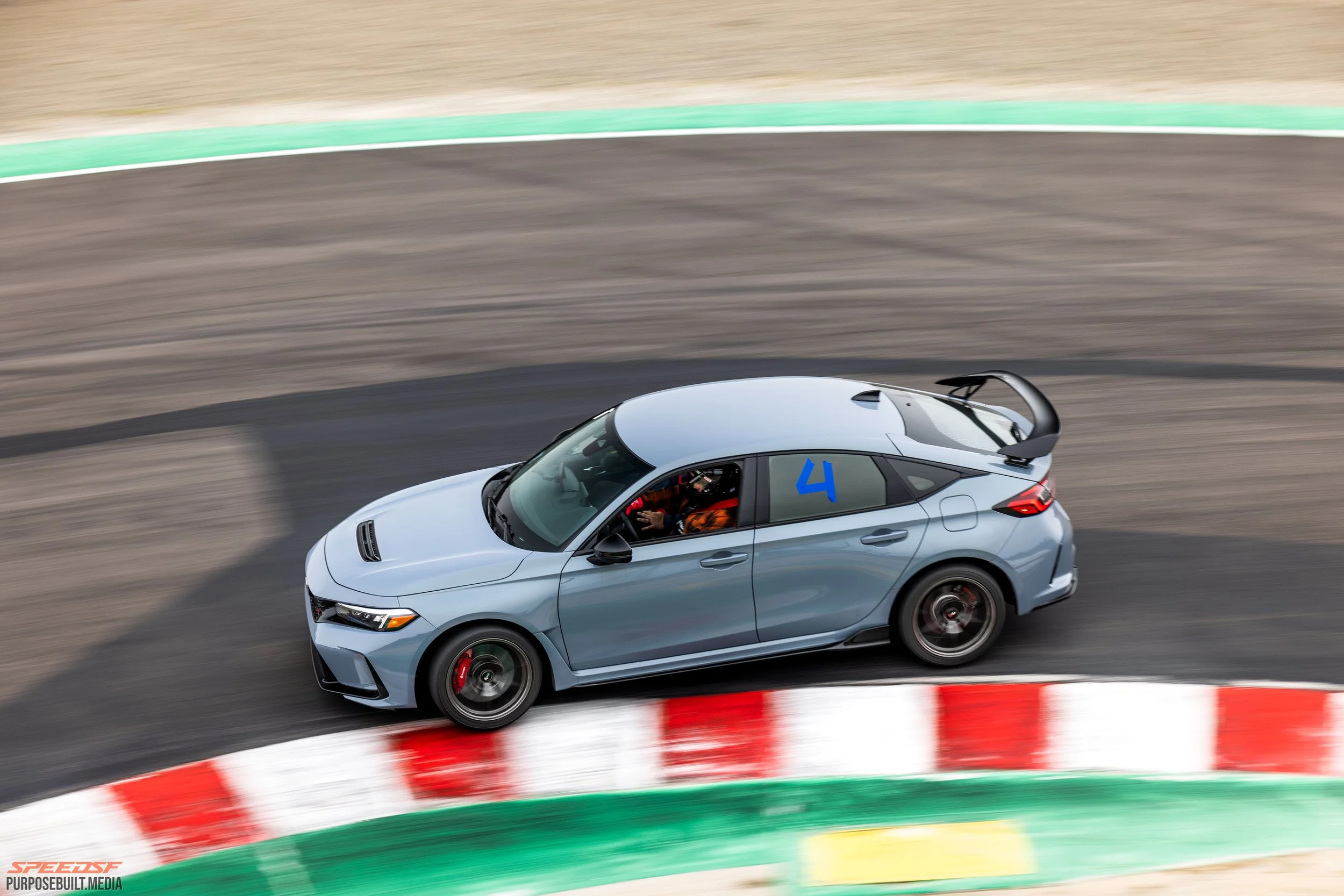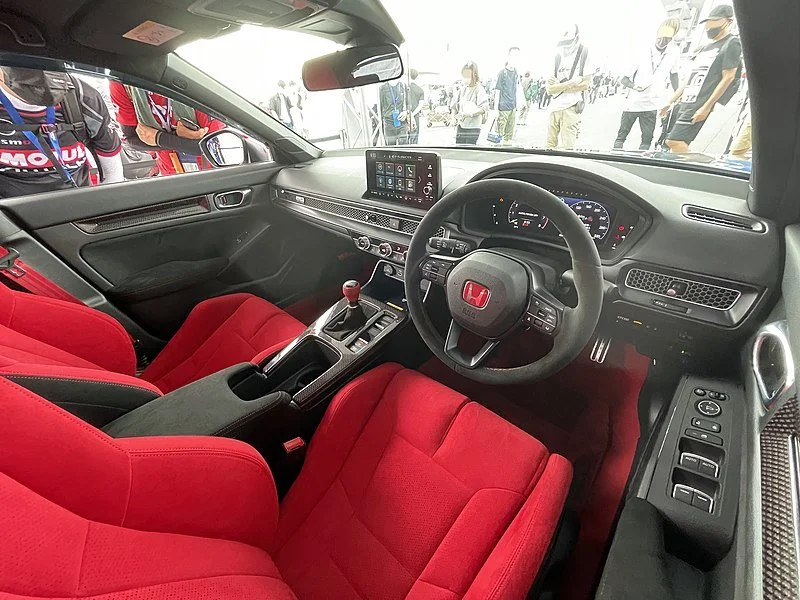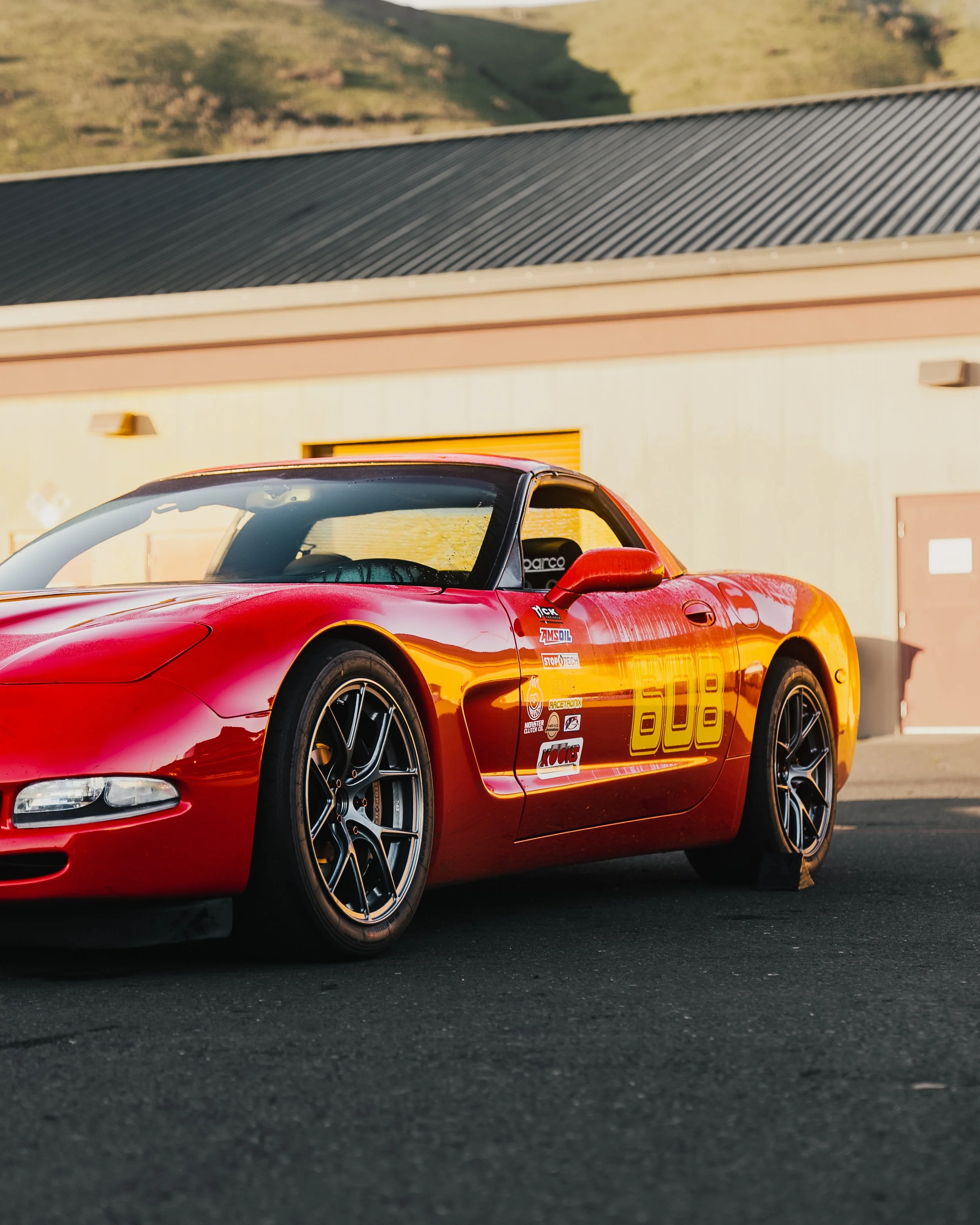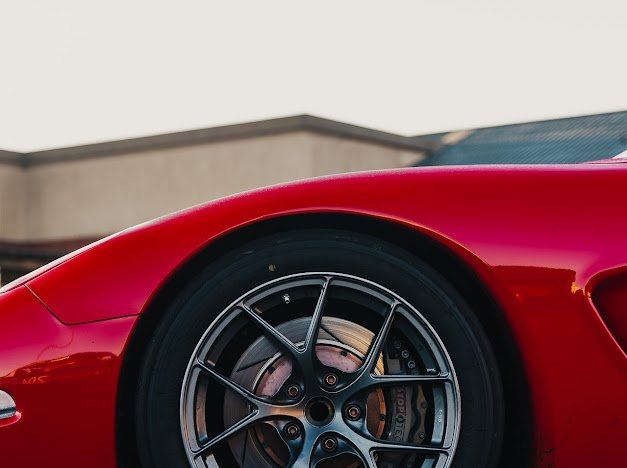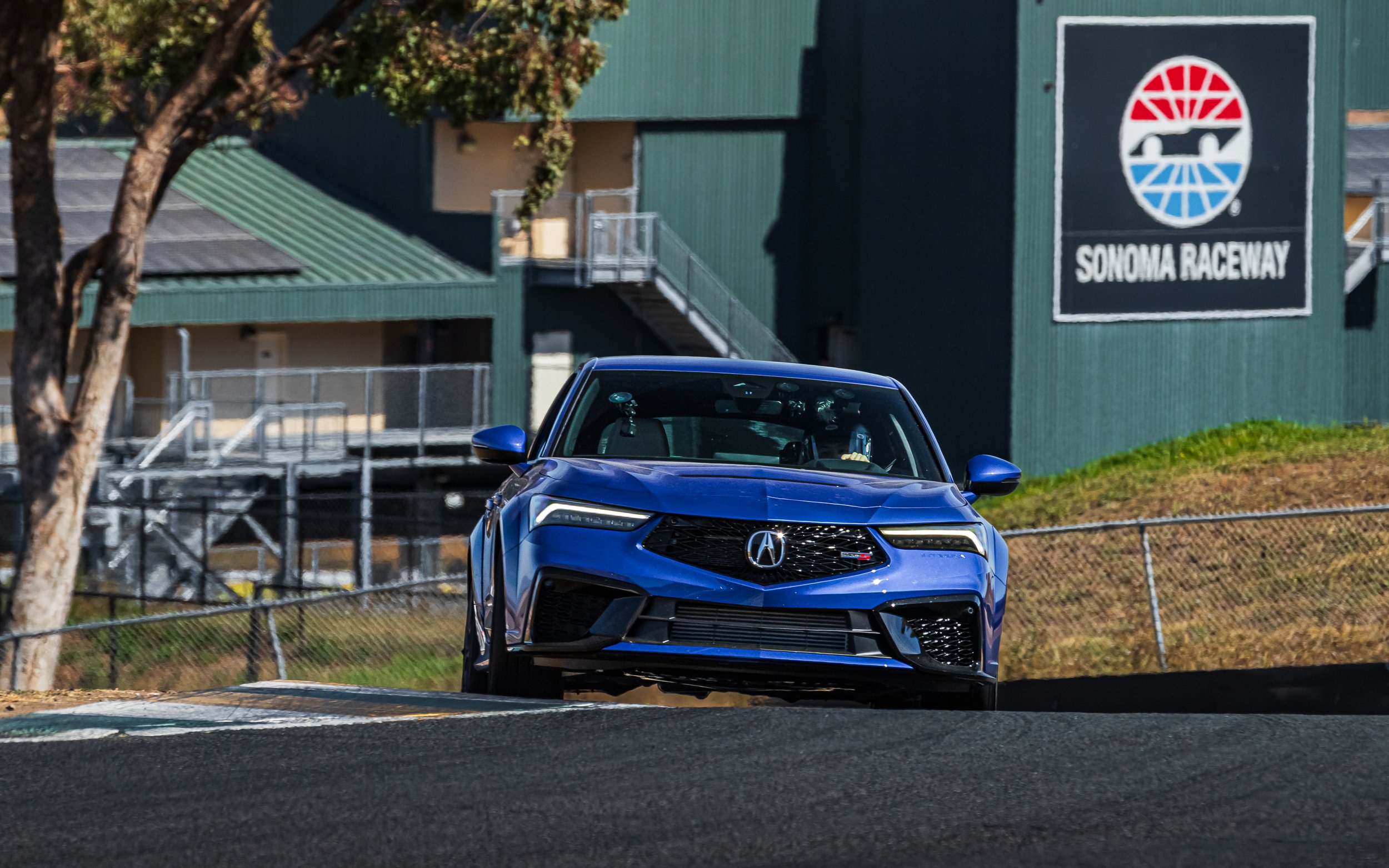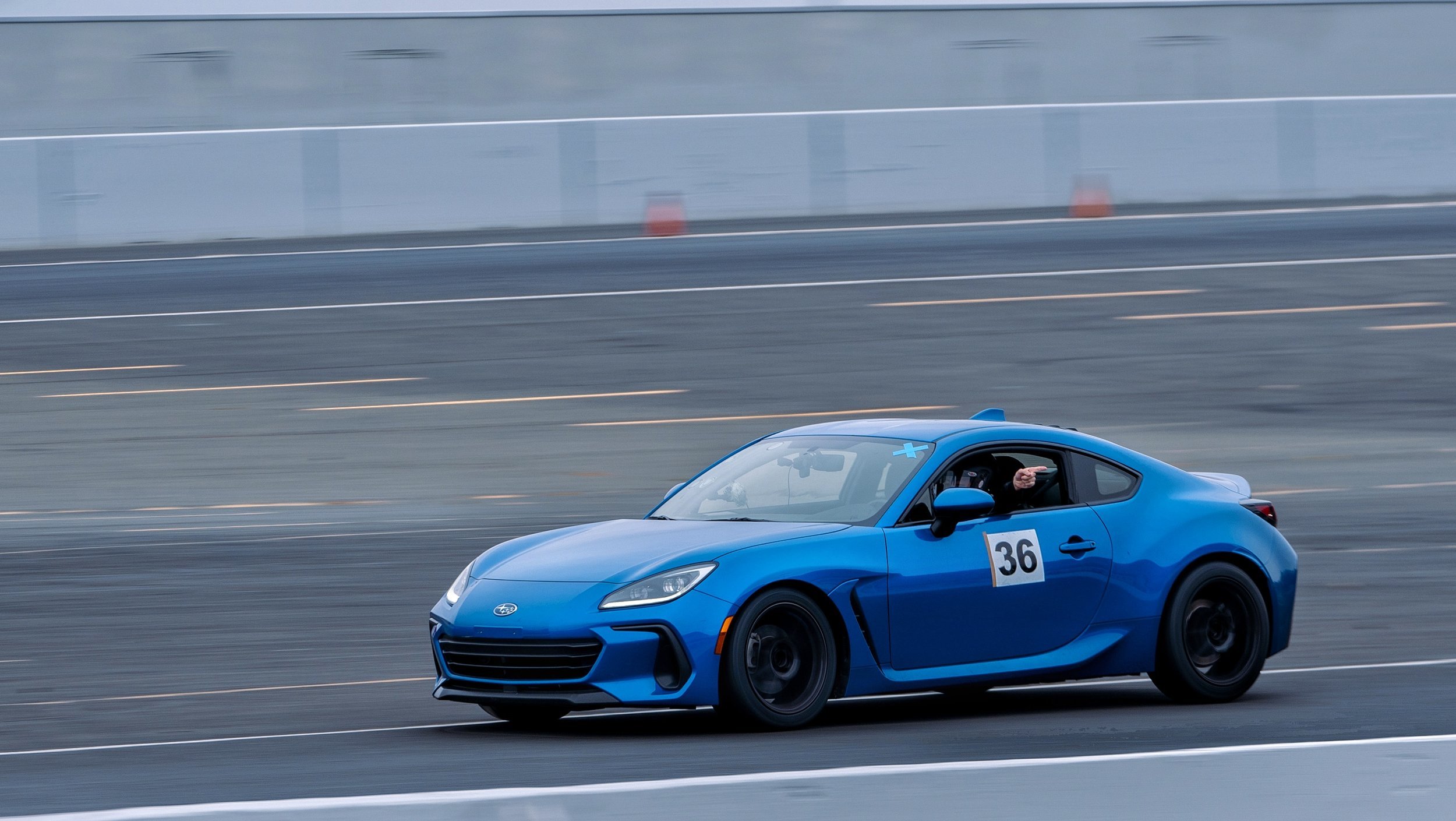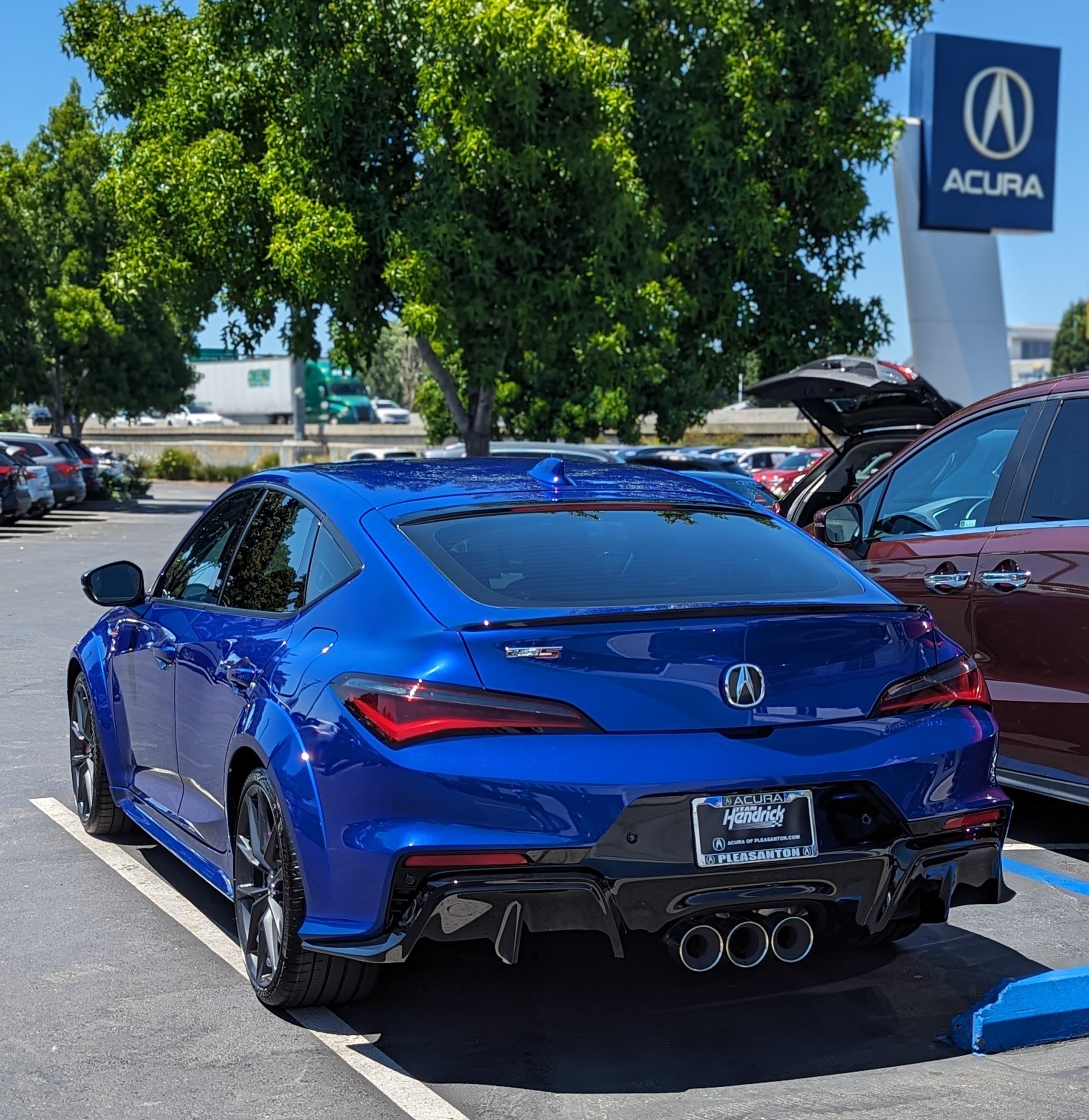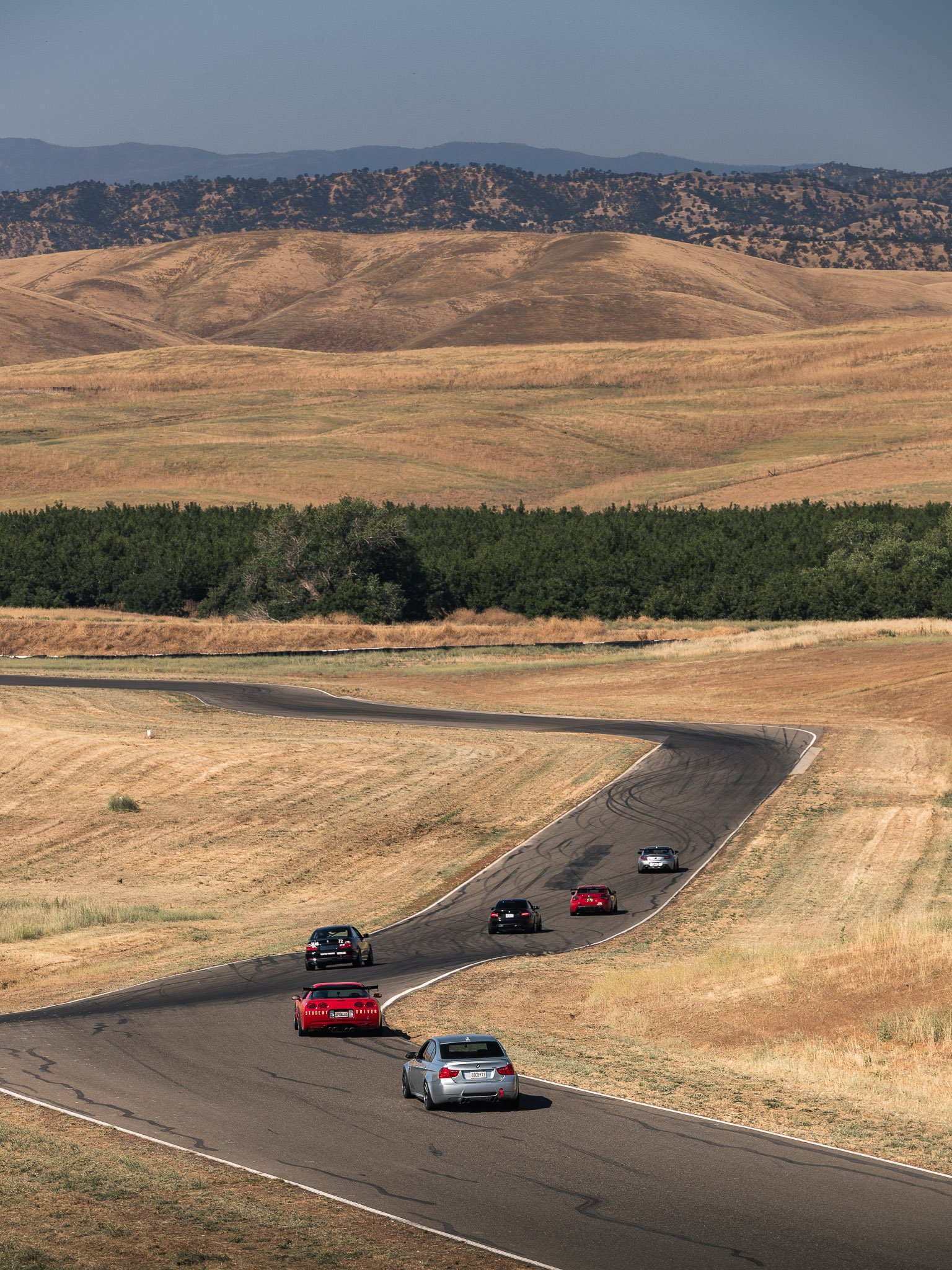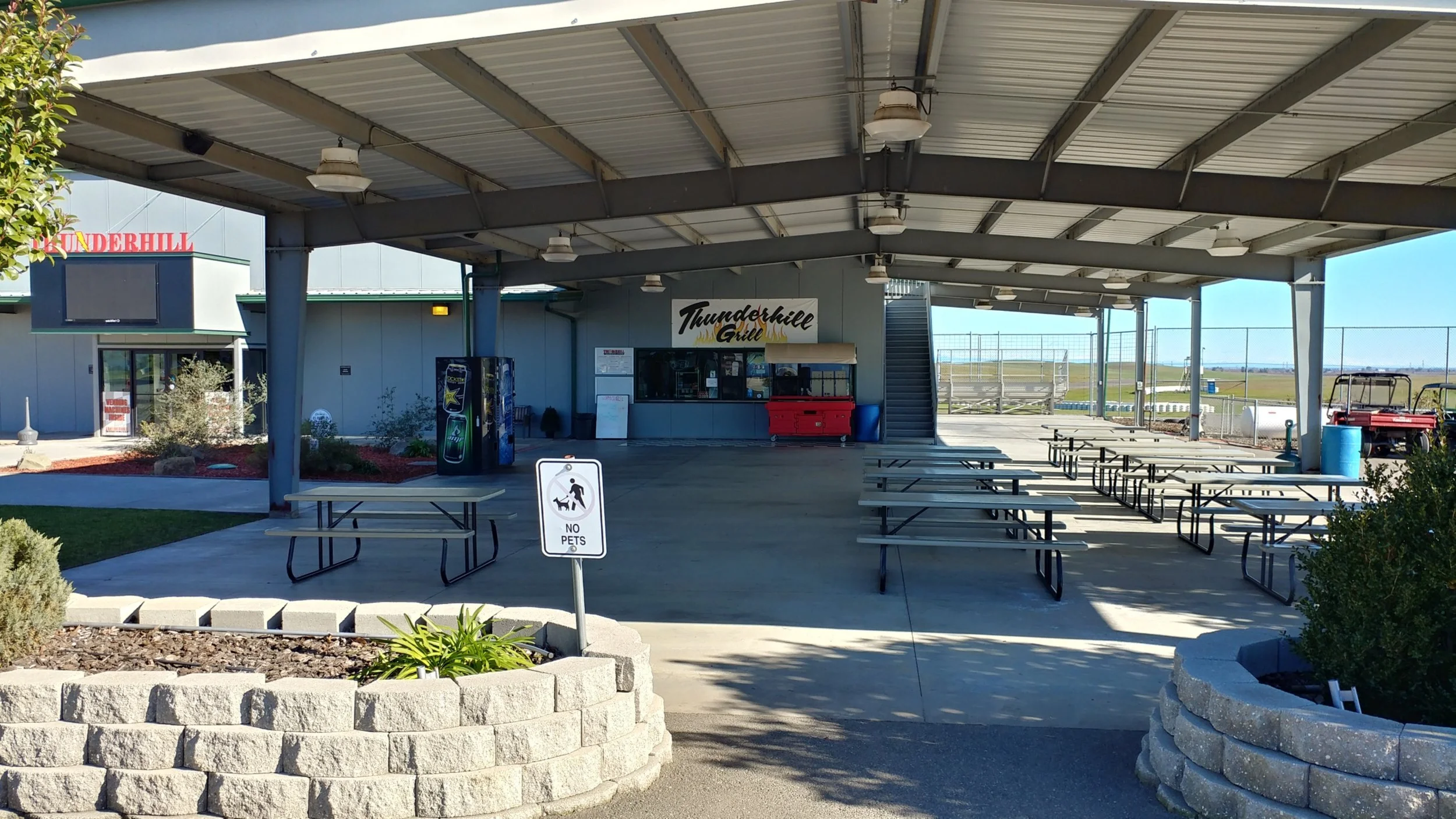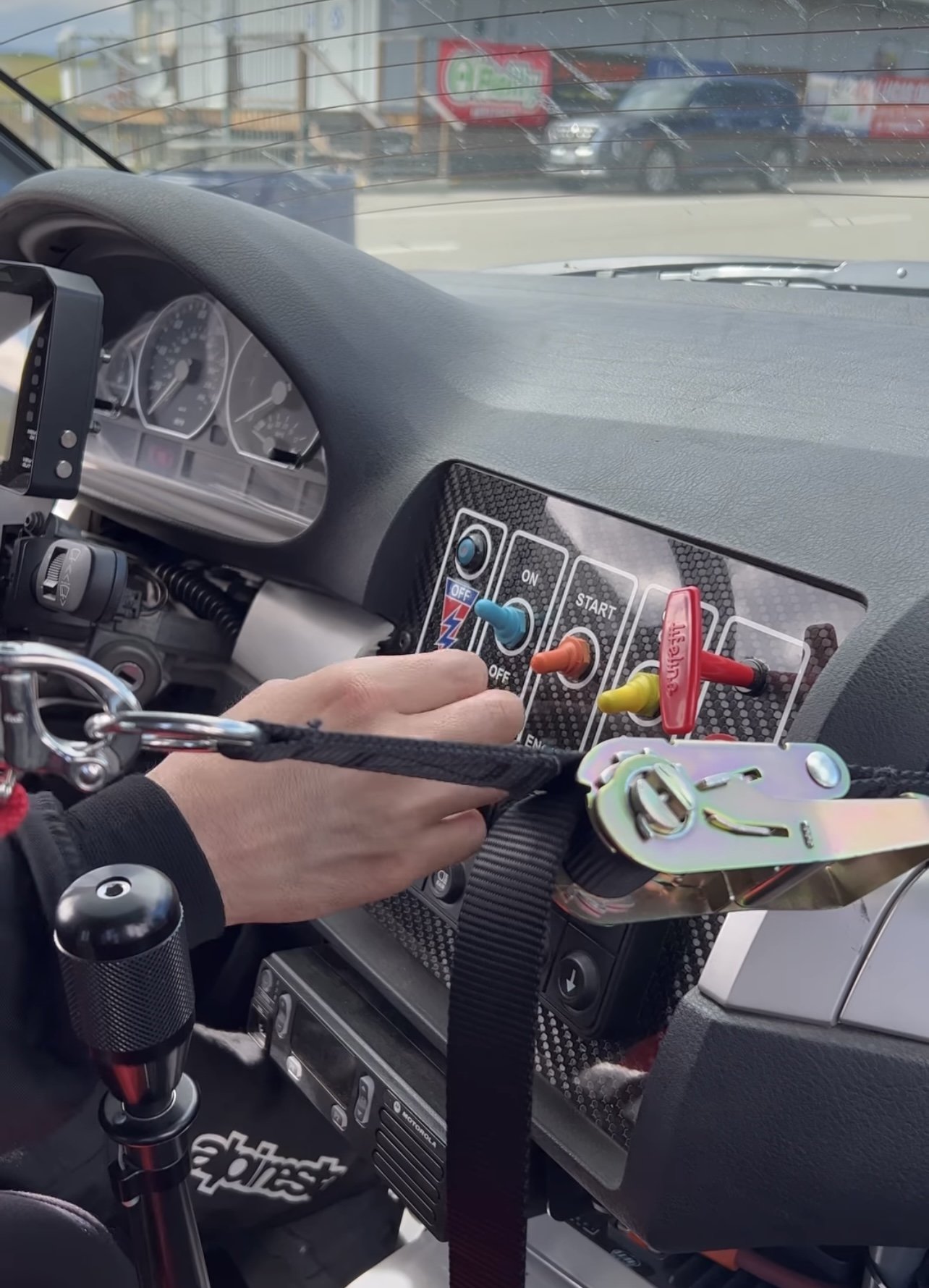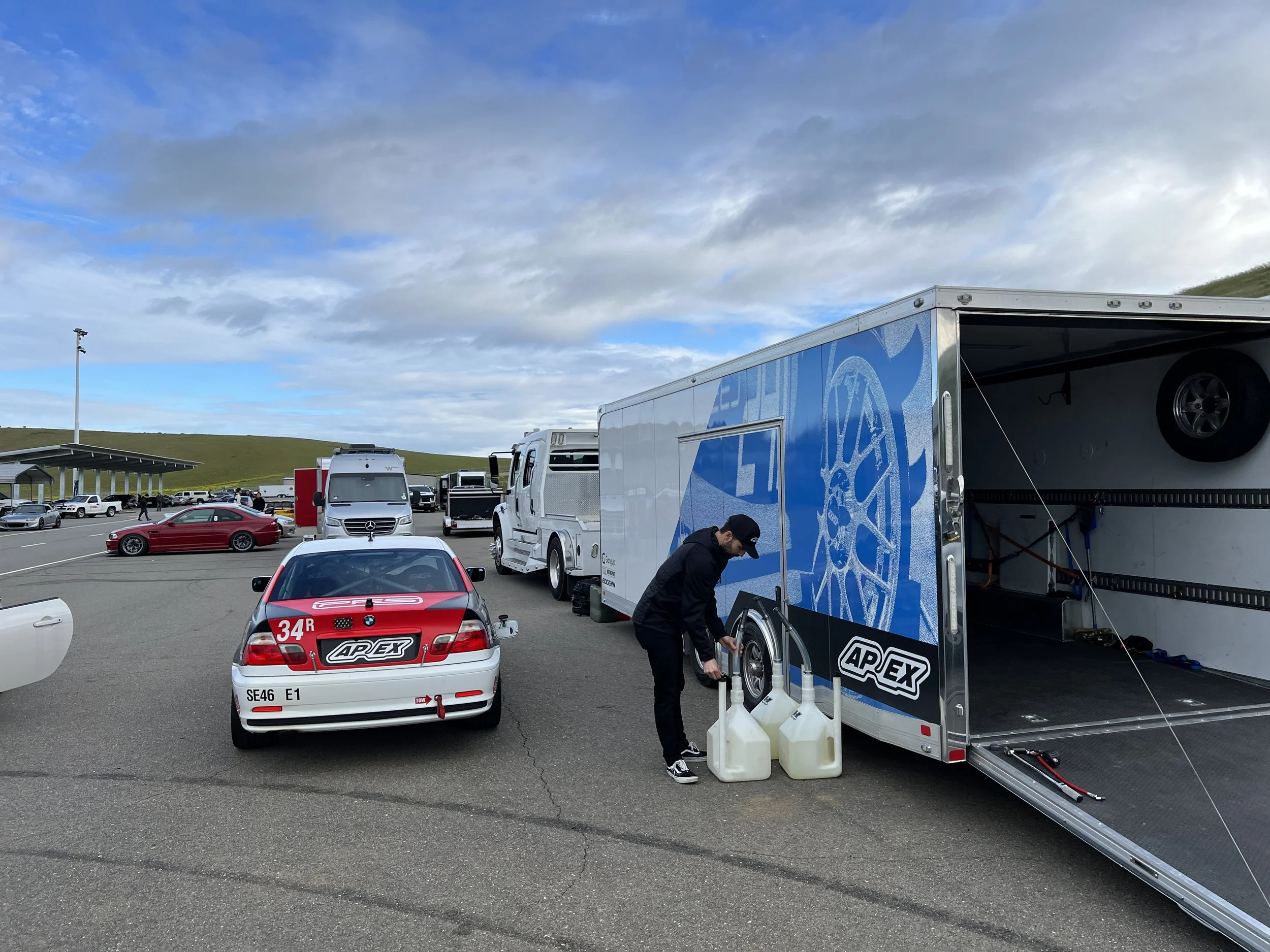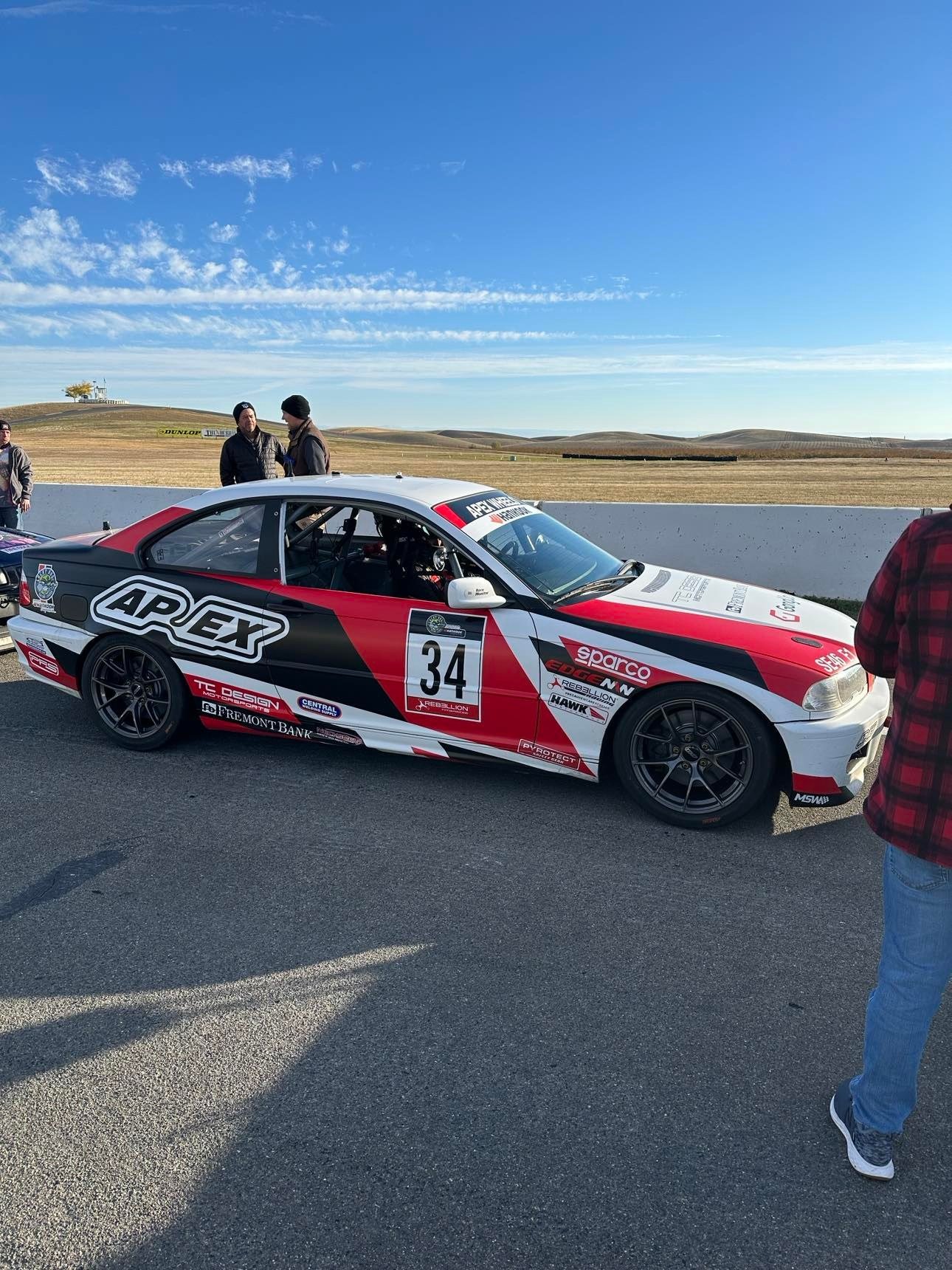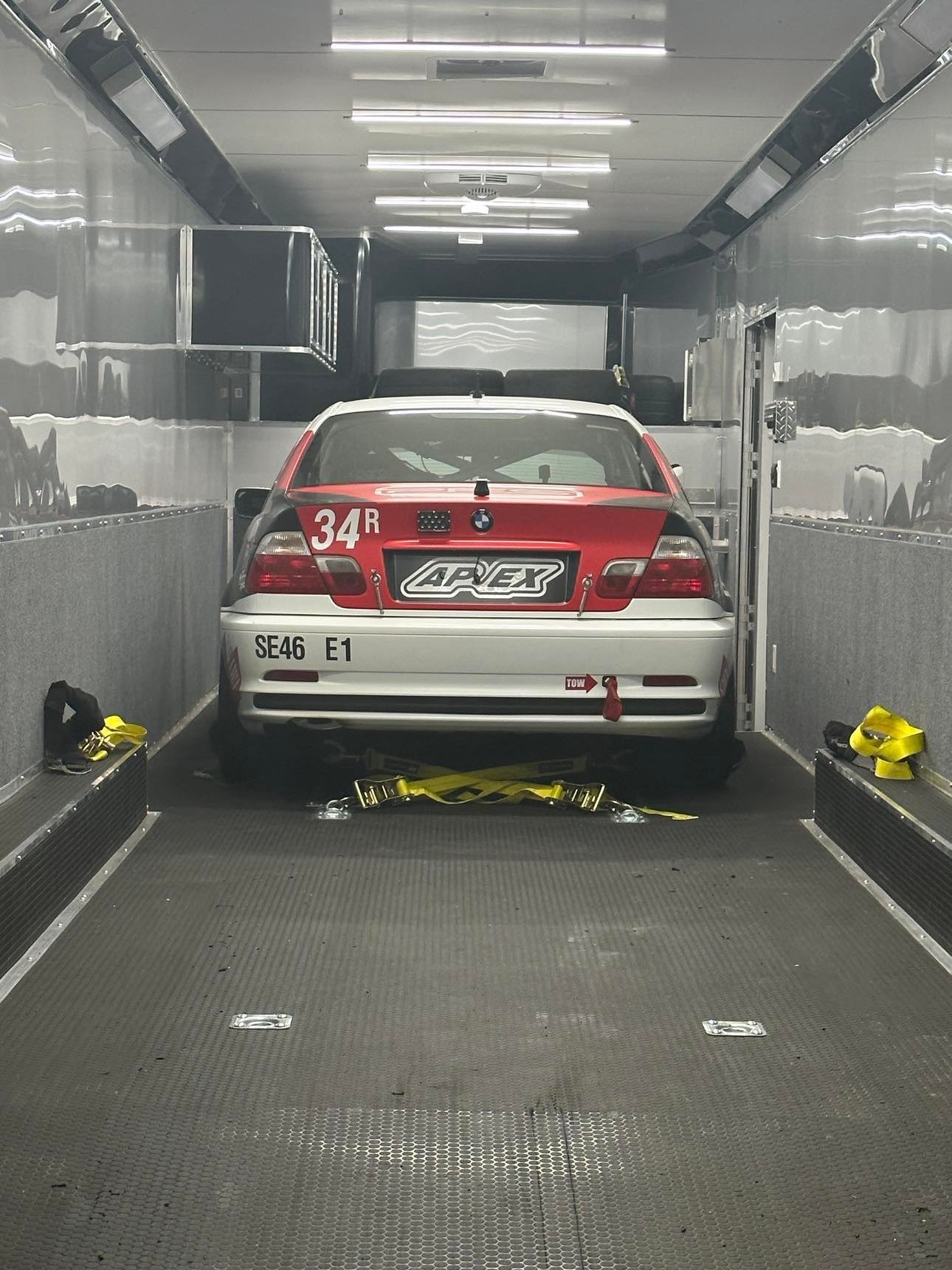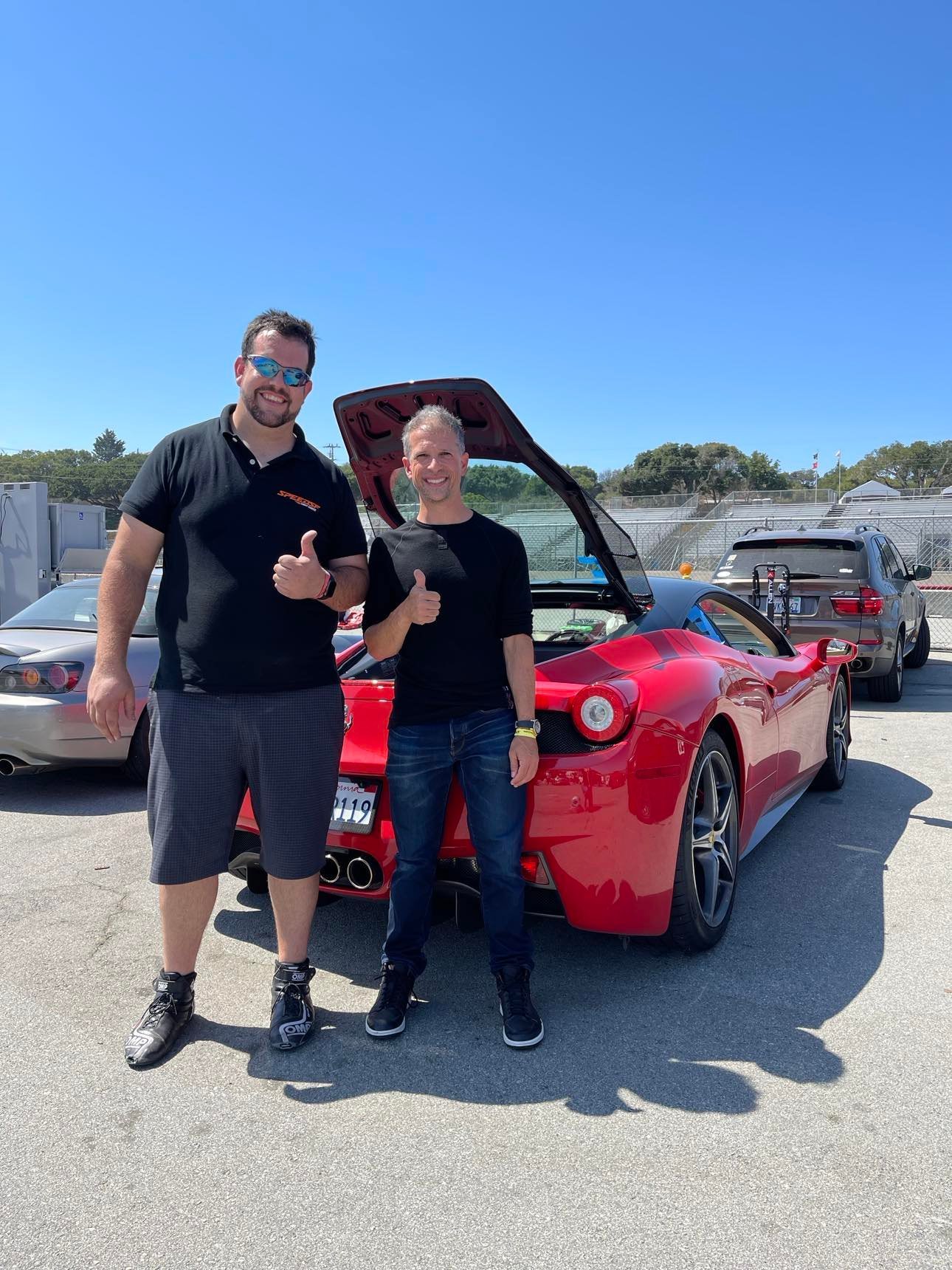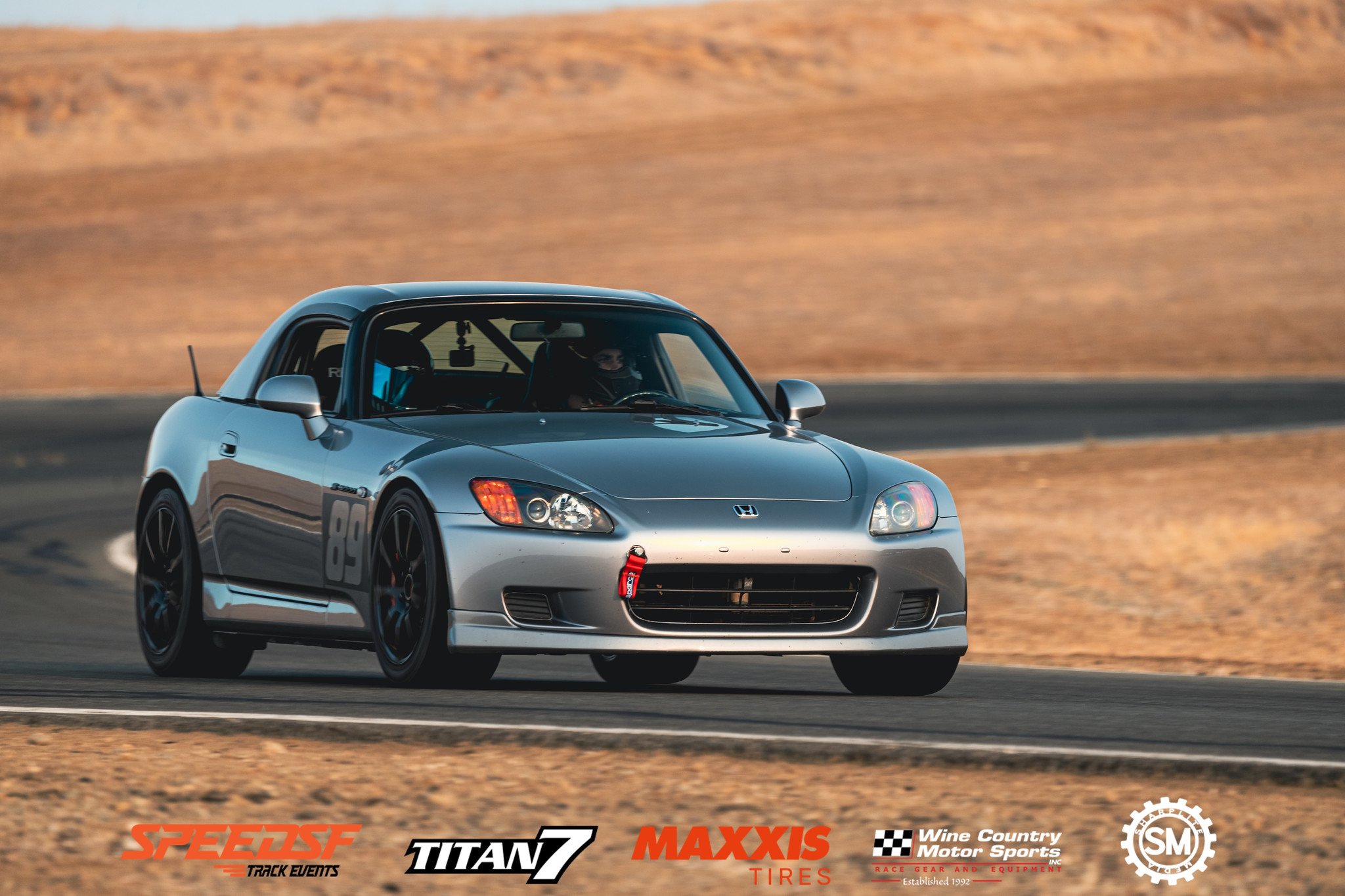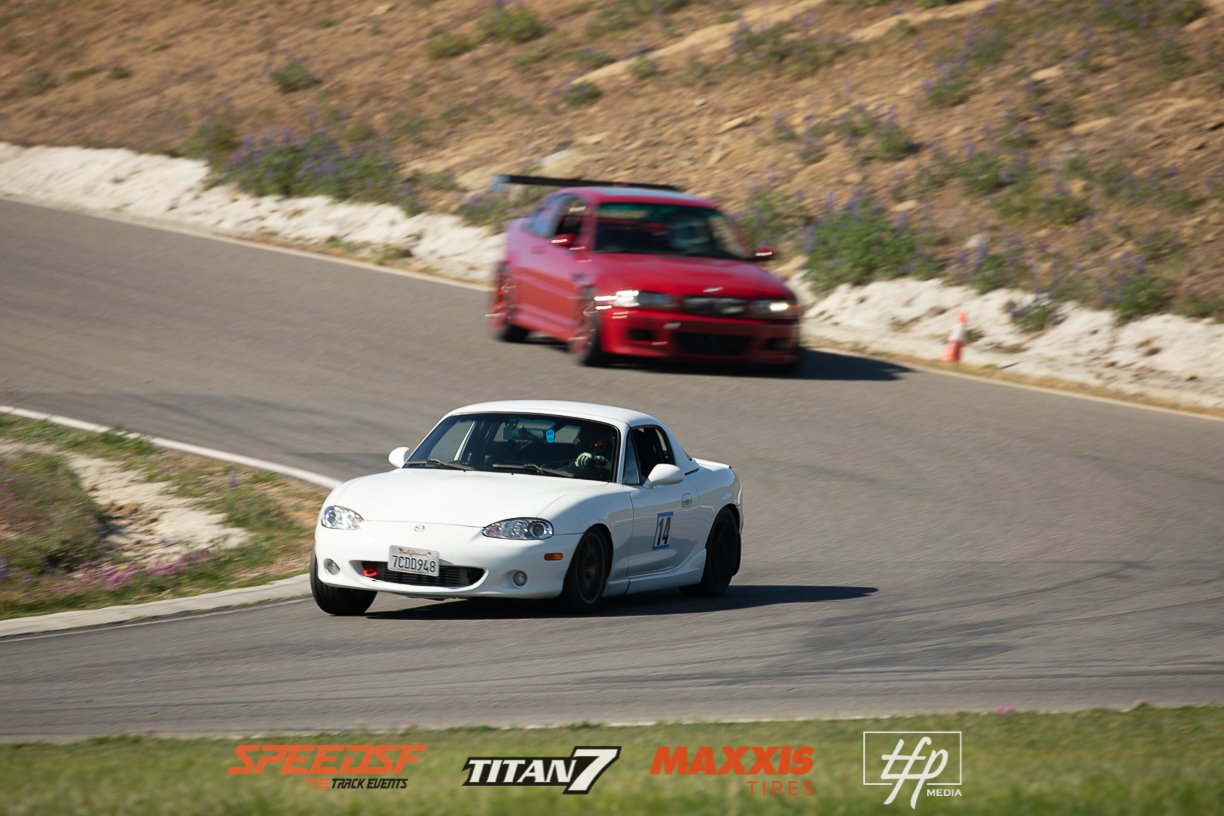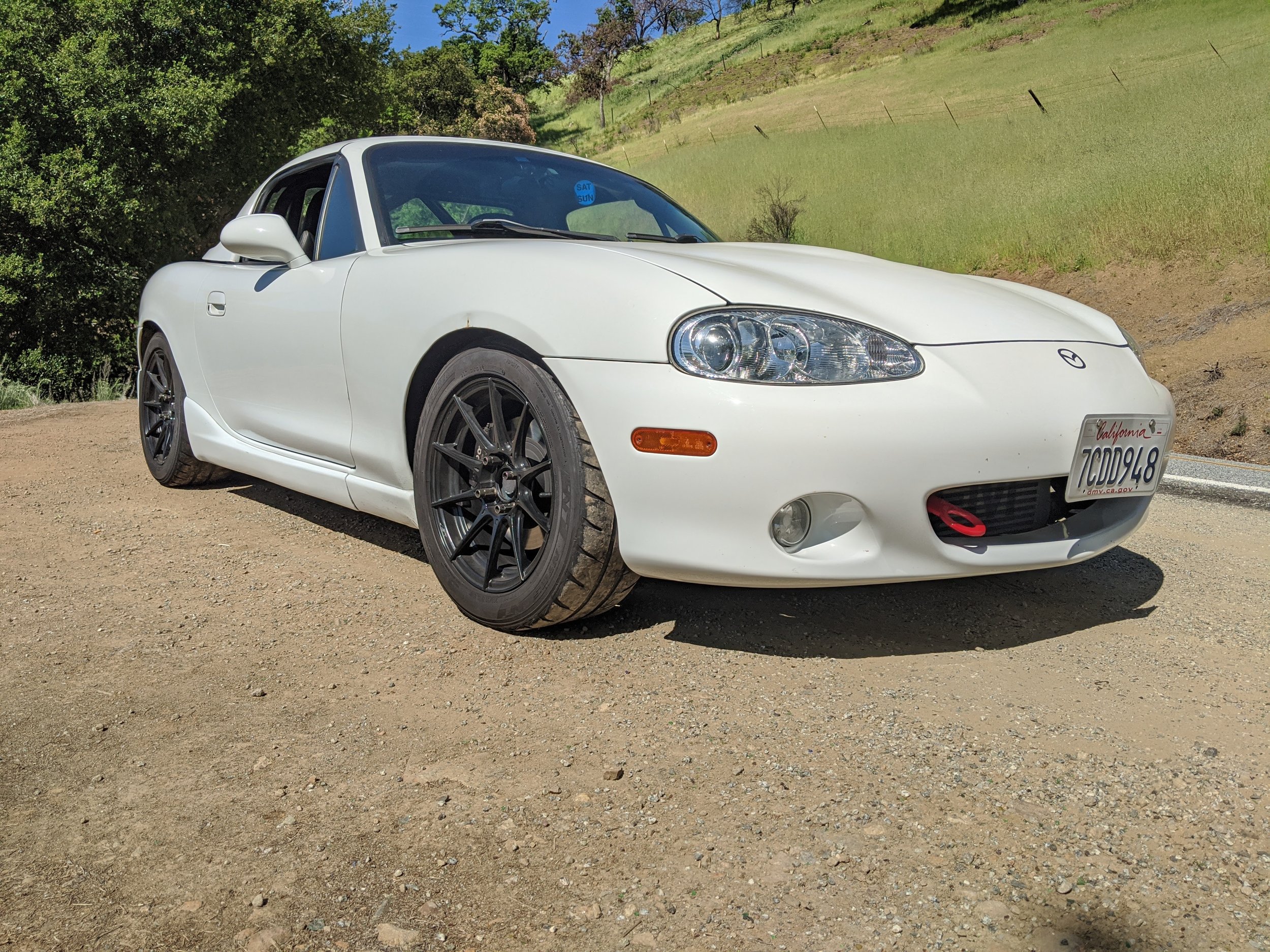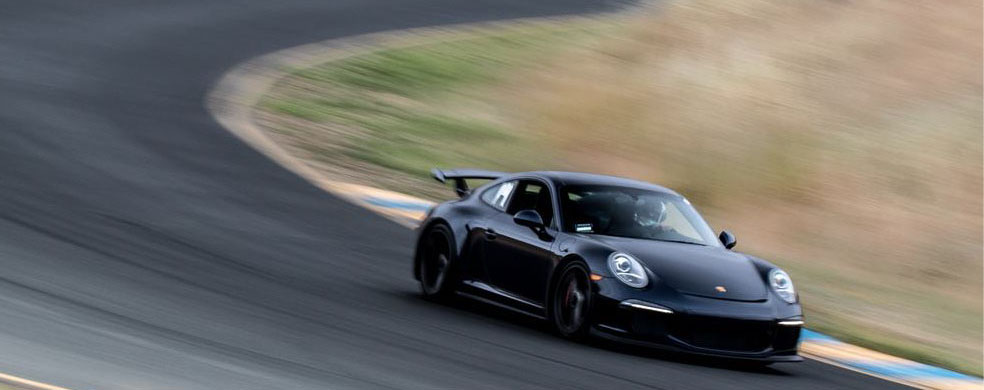
Alex’s FL5 Type R: Best of Both Worlds
The FK8 was too gaudy, the MX-5 was too cramped, and the FL5 was just right. When Alex was able to bring home a new Civic Type R for the occasional track outing, he knew he’d found the best possible compromise within his budget.
For Alex Peysakhovich, living in NYC had its perks, but easy access to track days was not one of them. When he relocated to Los Altos and found himself with a backyard and a garage, he decided it might be time to purchase that car he’d always wanted and take advantage of California’s temperate weather and multiple tracks within a few hours’ driving distance.
His heart was always with Honda, but the then-current FK8 Type R was too boy-racer for his liking. “I really loved the car, but thought about some things you have to do with your only car, like go to a business meeting or drive in a funeral procession, and I couldn’t really imagine doing those in an FK8.”
So instead he began tracking with an ND Miata. Heavy modification made it a capable cornering machine, but its impracticality became a constant pain; it needed a trailer for long drives and couldn’t be used to take his dog and his girlfriend on weekend trips. He thought about getting an electric daily that he wouldn't track or modify, but that idea didn't last long. “What’s the point of buying a car you’re never going to take to the race track?” he asked himself.
Enter the FL5 Civic Type R, which debuted after a couple years of tracking the Mazda. The new Civic traded its predecessor’s divisive looks for more subdued styling, so Alex had to check it out for himself.
“I used to think Type Rs were a little overhyped, but after seeing it in person, I recognized why the car has a cult following,” he said.
He appreciated the way Honda’s engineers made this fifty-grand Civic feel unmistakably upmarket. But more than presence or build quality, it had real-world usability going for it. On longer trips, the comfortable seats were a welcome upgrade from his Miata’s race buckets. The interior space, the fit and finish, and the performance made the FL5 a great candidate for a daily driver-come-sleeper, and once the premiums started to shrink, Alex pulled the trigger and brought one home.
Before his first track outing, he made a few adjustments. He’d learned enough to know that a ~3,200 pound front-driver would wreck its Pilot Sports fairly fast, so he ditched those for a set of 265-section Bridgestone Potenza RE-71RS tires wrapped around Apex VS5-RS wheels. Along with a set of eccentric lower ball joints to increase negative camber at the front axle, he replaced the stock pads with a set of Ferodo DS3.12s to help clamp the factory two-piece rotors.
He broke it in over 600 miles then took it to Thunderhill West for its shakedown, where he was pleasantly surprised. The steering was quick, despite a dead spot at twelve o’clock, and the gearbox was, well, Honda. If the interfaces were lacking in any way, it was the position of the throttle — as he put it, “in another zip code.” Thankfully, the auto-blip function facilitated heel-toe shifts despite the awkward pedal placement.
Being a front-drive car, he had expectations for how it might handle on a damp morning. Those were dashed on his first fast lap after mounting the dorito at Turn 3, when it hung the rear out in a big way.
“As far as a car that can pack a weekend of camping gear and do great times around Laguna, it’s a hard car to beat.”
The FL5’s mechanical LSD and brake-based stability control system do a commendable job getting the middleweight to rotate. What was less than impressive were the thermal problems which have been associated with the turbocharged Type Rs. Though not catastrophic, the heat causes the motor to pull timing by the end of a long session, but never puts it into limp mode. “I think there’s only so much you can expect from a turbocharged two-liter making over 300 horsepower,” Alex added.
Fortunately, these issues are not new to the Type R lineup and the FL5 was designed to make them easier to address than its predecessor ever allowed. The ducting routes have been established from the factory, along with a functional hood vent. Honda laid the groundwork, but more needs to be done for hot summer days. “It isn’t imperative, but it could use a bigger radiator and an oil cooler. I’ve got those sitting in my garage in anticipation for the summer.”
“The designers cared about the experience of the car; they wanted it to feel special, even when parked.” Alex added. Credit: Tokumeigakarinoaoshima CCA-SA 4.0.
Beyond that, any remaining mods are far from necessary. The FL5 is well-balanced out of the box and does not need much more power. “The engine is certainly strong. If it could use something to make it feel a little sportier, it would be an exhaust — it’s too quiet.”
That subdued exhaust note is part of what makes the car so versatile, and its wide repertoire comes at a premium. Besides requiring pricier fuel, the turbocharged front-driver is hard on its front brakes and tires, and it goes through consumables far faster than a lighter, better balanced car like a Miata.
There’s no denying the running costs are too high to track a Type R regularly — multiple track days per month will continue to be the Miata’s job — but the Civic will be doing daily driving, mountains, longer trips, and rear its head at Laguna and Thunderhill East a few times a year.
Four years ago, Alex thought fifty thousand for a Civic was steep, but he’s changed his tune as of late. “I know that sort of money for a Civic sounds crazy, but you really need to try it. It’s tough to think of something similarly priced that handles so many different tasks as well as the Type R. If I could only have one car, this would be it.”
Thomas' Corvette: In Good Company
In only two years, Thomas has learned more than most will grasp in a decade of track days. Having a solid, dependable C5 has helped him put in his time, and having Elite Performance as a resource has made fine-tuning the car so much simpler.
Finishing out his senior year of high school, Thomas DiGioacchino listened to a friend’s suggestion and scrounged the money together for his first track day. Crap tires, decent weather, and a near-stock Mustang GT were all he needed to find that thing that’s been steering his life for the last five years.
Thomas decided to pursue the mechanical side of things and enrolled in Ranken Technical College’s High Performance Technology course with a focus on Chevrolet LS engine design.
That emphasis allowed Thomas to build a motor for a car he hadn’t yet bought. It began with an iron-block LQ motor and LS1 heads, and as the LQ block only displaced 5.3 liters, he bored and honed it out to 5.7 liters to fit the LS1 head. With forged pistons and rods, oil pan baffles, and the other pieces that made it a 500-horsepower workhorse, he unknowingly set the tone for the rest of this build.
The car itself came next. During his final year at Ranken, he found himself a base 2002 Corvette within his price range and tucked it away in his side yard until graduation, when he loaded up his truck with his furniture, his motor, and began his drive from Missouri to his hometown.
Back in San Mateo, he reached out to his then-limited network for car parts and, with some luck, gainful employment as well. As he’d relied on Elite Performance to direct him towards a few bolt-ons for his Mustang, they were the natural resource to consult. One day, while speaking to Elite’s Melody Cannizzaro about getting his Corvette aligned, she provided up with a job opportunity. He didn’t have to think twice.
Working with Elite gave him access to one longtime customer who happened to be offloading some go-fast bits from their recent Corvette build. Thomas was able to grab a set of Titan 7 T-S5 wheels for peanuts, and then came big brakes, bushings, and a bucket seat. Soon, the plans for keeping the Corvette tame and civilized went out the window.
Wisely, he went for safety equipment next, and decided that this car would only help him become a truly quick driver if it was reliable first and fast second. “I knew that seat time would be the priority if I was going to run with guys like Gary Yeung,” he said.
That said, it would be silly not to make use of the big motor sitting in his parent’s backyard. Soon, it found a new home in the Corvette’s engine bay, and Thomas took the half-built C5 to its first track day, where it ran without a hiccup. It ran well the second day, too, as well as the third. Clearly, he’d paid attention in class.
Aside from the minor repairs any twenty-year-old car needs, it was the epitome of dependable. His focus was on learning to drive the car better, but, to his credit, a C5 on stock suspension does leave a lot to be desired. It would lean excessively, and under trail braking, it had a habit of snap-oversteering.
After several months of saving, Thomas bought a used set of JRZ two-ways. While he was at it, he pulled and refreshed the entire drivetrain, then upgraded the springs and clutch packs in the OE LSD. Those modifications made the Corvette much more progressive at the limit, regardless of whatever cheap tires he happened to be running.
When he found the time to fine-tune the suspension, he increased the rake to increase rotation at corner entry. A square 295-35/18 setup was the cost-conscious tire option, and he stretched every set until the cords showed. Still, the car was mostly neutral with a hint of understeer in the faster stuff thanks in part to his APR GTC-300 wing.
As his confidence grew, he started to recognize that driving around on worn rubber was no longer the training tool it had been, so he sprung for a set of AR-1s and turned his first sub-two-minute lap at Buttonwillow 13CW. “I had to fight it the whole way around, but I got 1:58. A sloppy 1:58, but still,” he said.
Good tires helped, as did having a hare to chase. With Gary Wong driving his S2000 off into the distance, Thomas was able to see where he could push harder than he believed was possible. It’s a huge help having an experienced driver luring your outside your comfort zone.
Logging that first milestone lap gave him the confidence to try the Speed SF Challenge the next weekend at Thunderhill’s five-mile configuration. He did his homework and studied several record laps, focusing on curb usage. With Gary Yeung giving him some basic feedback the day of, Thomas saw his lap times fall by as much as four seconds. In the end, he was able to clinch third place in S2 — just half a second behind Kevin Schweigert in his BMW M2.
That success turned Thomas into a sponge. His subsequent lapping days have been spent studying data and having the experienced drivers like Joe McGuigan critiquing his onboard videos. “Joe’s been a huge help; giving me pointers on which gears to use so I can put the power down more easily.” The result of this traction-conscious approach to driving is evident in the footage below:
He’s also benefited from picking a short list of prime parts. In fact, he’s never bent his Titan 7 wheels or broken any suspension parts, despite hammering curbs and dropping wheels regularly. Maybe it has something to do with emphasizing robustness with this build—a tip he picked up from his mentor, Gary Yeung.
‘I’ve learned a decade’s worth of motorsports knowledge in the last two years. Everyone’s been so supportive, and I owe my progress to all of them. They’ve pushed me to improve as a driver and a builder—especially Gary. Watching him work inspired me to raise my game, and I think it shows. My Corvette’s overbuilt, so I can push it all day. Like Mango, my Corvette is a workhorse that’s made it possible to attend almost every Speed SF event in the last two years. All I do now is change the fluids and try to find out where I can go faster.”
Parts
JRZ motorsport coilover conversion
Titan 7 T-S5 wheels 18x10.5”
Trackspec hood vents
Dewitts radiator
Spal fans
Improved Racing oil cooler
Improved Racing oil pan baffles
Prothane polyurethane bushings
APR GTC-300 wing
APR splitter
Fenton's Integra Type S: A Change of Heart
While he was on the fence for a while with Acura’s bigger, boatier Integra, the Type S had enough of the right stuff to convince him to try this front-wheel drive super sedan.
“I used to be the biggest hater of FWDs,” he started. Despite his introduction to cars coming in the form of a Civic, he rapidly transitioned into rear-drive platforms when he took up track driving. After a pair of S2000s, he moved onto Porsche Caymans, 911s, and, most recently, a Subaru BRZ. What they all had in common was their rear-drive layout, which cemented in Fenton the belief that all other drivetrain configurations were beneath consideration.
Lately, he’s had a change of heart.
It was an unexpected decision to sell his BRZ. Oil starvation issues concerned him, but he had also owned the car for eighteen months and was starting to wonder what decent replacement was out there—something new, fun, and practical between fifty and sixty grand.
Actually, he was a little more particular than that:
1) It had to be track-capable.
2) It had to have been endorsed by Throttle House, savagegeese, or TheTopher.
3) It had to be at least as practical as the BRZ.
4) It couldn’t break the bank in the event of an incident.
Not much in that price range met his requests, but the faster Hondas, despite driving the wrong axle, were fairly close. But it was more than the drivetrain that deterred him at first.
“I remember when the base Integra was first announced, I thought Acura was disrespecting the Integra name. It looked like a boat; it had no resemblance to the DC2 or the DC5 and, I believed, was probably an overpriced Civic.”
A few months later, the Integra Type S was announced, and Fenton found himself torn. “I started to love the way it looked. Even though the general shape was the same, they tweaked the right areas to make it look like a driver’s car. This had proper flares, an aggressive rear diffuser, a vented hood, gaping intakes—it was unique and purposeful.”
“The Integra wasn’t really on my radar until, one day, I was bored at work and decided to configure a car on the Acura website. I specced out my ideal Type S, and figured I’d add my email to their list—why not?
The next day, Acura of Pleasanton, just seven miles from my house, contacted me and offered that exact car at MSRP plus $1,000 of non-negotiable dealer add-ons. One prospective buyer had backed out and my name came up on their list.”
At the time, he’d been considering the FL5 Civic Type R, though the markup was significant. Plus, the car has a number of creature comforts and tuning differences over the Civic that makes it a better daily. An Integra-specific re-tune of the K20C1 engine, shared between the two, provides much more mid-range torque. Additionally, the Integra’s electronic dampers benefit from new tuning to make it a more supple road car.
The case in favor of FWD was growing, but he still had his bias to overcome. “I used to believe that, if you cannot powerslide it out of a corner, it’s not a sports car.
However, he couldn’t find anything else under $60,000 that is spacious, has a backseat, has a manual transmission, is track-capable, and is rear-wheel drive. I realized that, in order to hit my price point, I’d have to make one or two concessions.
I figured I’d at least give the Integra a try. In person, it looked fantastic, and it felt like a $50,000 car inside. It was something I could live with on a daily basis. The shifter is nearly as good as a Honda S2000’s, the ride quality is phenomenal; with the dampers in comfort mode, it rides almost as well as a luxury car. It has minimal torque steer and phenomenal brakes. After driving it around the block, I was sold.”
He bought it that day.
Since then, he’s beaten nearly all of his previous bests. At Laguna Seca, Thunderhill East, and Thunderhill West, he’s beaten his bests in the BRZ by 2 to 3 seconds. Some of that has to be down to Integra having twice the torque, but, as Fenton’s learned, a FWD car might be easier to come to terms with.
“I can lean on the car more confidently, whereas the BRZ would break away more abruptly. I know that, on turn-in, it’s going to understeer, and while that might sound boring, it means I can get up to speed a little bit faster, especially on cold mornings.”
At Laguna Seca, he drove the tires off his car—literally. Underinflating the PS4S tires to try and keep them in their ideal range seemed sensible, but during turn-in to Turn 6, the front-right tire debeaded. “I only stopped a few feet from the wall. It taught me not to track 30-profile tires with soft sidewalls any longer.”
If there was one issue beyond that, it was the lack of support from the stock seats. “The OEM seats are inadequate for track driving; they are the same design as the base Integra with very little bolstering. The OEM FL5 seats are supportive and soft enough for daily driving and track duty. I’d happily exchange the Integra seats’ heating and electronic adjustability for the FL5’s greater versatility.”
And so he started adding the first round of modifications, beginning with a set of 18 x 9.5” + 45 Apex VS-5RS wheels wrapped in Kumho 265-35 V730s (the same as he had on his BRZ for fair comparison), as well as a set of Ohlins Road & Track coilovers.
The Road & Tracks have a reputation for being more road than track, but the Integra-spec 6kg front and 10kg rear springs are much stiffer than what’s normally offered. “The spring rates have helped a lot with tucking the nose. You can get consistent mid-corner rotation with a lift-off the throttle.”
Along with those mods, he added some Castrol SRF fluid and a set of Endless ME20 pads from RHD Japan since the yen is weak now. Their torque rating is much higher than the standard pads, which were at least resilient enough to run sessions at Laguna without fade.
With the first round of modifications in place, he took it to Thunderhill West and ran a 1:24 in his second session—some 2.5 seconds faster than he ever went in his hardcore S2000 on Federal tires. “It felt adjustable; it wasn’t a battle against understeer in every corner. You can transfer weight with the inputs and rotate the car in small, measurable increments. That’s something I find a modern GTI just won’t do.”
Most recently, Fenton ran Thunderhill East Bypass for a day that he found encouraging, if not a little frustrating. After spinning in the first session and getting the black flag, he found himself without traffic in the second session and logged a 2:01. “I believed I could find another one to two seconds in the third session, but one of the flaws of the car held me back.”
In order to completely avoid fuel starvation, the tank needs to remain above half-full. After dipping below the middle hash five minutes into his third session, he spent the remainder dealing with fuel cut. He couldn’t leave too miffed; he’d only had one real session to push the car, and with that 2:01 indicated on his Garmin, he’d already gone three seconds faster than he ever had in the BRZ.
Considering he’s only done three modifications and is already three seconds faster than the BRZ, he has no regrets. “I might not be powersliding it everywhere, but it’s taught me that there are other, subtler ways of manipulation.”
Beyond all this, I can drive to and from the track in complete comfort. With radar cruise control, lane-keep assist, blind spot monitoring, heated seats, a premium ELS sound system, and even a sunglasses holder—I’ve never been so comfortable on my way to and from the track before. Going from a partially gutted S2000, to my mostly-practical BRZ, to this, I’ve experienced three distinct improvements in comfort. Plus, I can ferry people around. There is plenty of space for four adults—roughly the interior space of an Accord from fifteen years ago.”
It’s still a little too quiet to hear with his helmet on, so he’s planning on upgrading to a modest exhaust that should make it easier to gauge where he is in the rev range, reduce backpressure, and find a little more grunt. That said, it’s not lacking in that department; it has more than enough torque to run third gear through most of Thunderhill West. Oh—it could use more front camber.
In Fenton’s eyes, it deserves to be seen as Acura’s flagship sports sedan—it’s a deserving successor to the DC2 Integra Type R. “It’s a compromised car at the end of the day, and yet they have kept all those compromises from adversely affecting driving enjoyment. To me, it’s the perfect compromise.”
Thunderhill Logistics: Where to Stay, Where to Eat, How to Beat the Heat
With plenty of options for food and lodging, reasonable track fees, and plenty of ways to beat the summer heat, a successful trip to Thunderhill only requires a quick review of the information listed here.
If you’re not suited to warmer weather, the propect of spending a day in the sun at Thunderhill Raceway Park can be a little intimidating. True, there are the fair share of summer days in the mid-seventies, but they’re hard to pinpoint, and unless you’re willing to wait until the winter when the weather is wonderful, you might find Thunderhill a bit too hot for your liking. However, if you can brave the heat, the reward is worthwhile.
Covered spots are plentiful at both East and West tracks, but make sure to get one early.
With an interesting variety of corners, two separate tracks that are conjoined occasionally (not often enough), great sightlines, and plenty of runoff, there’s a lot to like about Thunderhill.
While it might not have the amenities of nearby Sonoma Raceway, Thunderhill is accommodating. The nearby town of Willows features several decent restaurants, a Walmart, reasonable gas prices, and a selection of mid-tier hotels that make it possible to spend a weekend there in comfort.
Walmart
470 Airport Rd, Willows, CA 95988
While gloom and doom isn’t the right tone to set the stage for one of Northern California’s most popular tracks, there are a few temperature-related concerns that should be considered—even if you’re as cool as a Bedouin. Always prepare for the heat. Bring a cooler and lots of water. You can buy ice at the track. You want to stay hydrated,.
Stay and enjoy a solid lunch at the Thunderhill Grill.
Though a quick trip back into Willows isn’t ideal after you’ve arrived at the track, it’s only a ten-minute drive—not that there are too many reasons why you’d need to.
Food at the Thunderhill Grill is good, there are many covered parking spaces (as long as you arrive early), and the track seems intent on expanding the covered area. Thankfully, there’s an air-conditioned clubhouse to beat the heat on the worst days. Outside of the hottest months, camping at the track is an appealing alternative to the sometimes pricey hotels.
Lodging
In town, the lodging is concentrated within a couple blocks. Most consider the Holiday Inn Express to be best, though there are a half dozen alternatives when it fills, which is typical on the busier track weekends. If you’re on a tighter budget, the Super 8 offers a pleasant place to lay your head. Expect prices to nearly double on the busiest weekends.
Holiday Inn Express & Suites
545 N Humboldt Ave, Willows, CA 95988
Super 8
457 N Humboldt Ave, Willows, CA 95988
The rolling hills around Willows are a wonderful sight, especially in the spring.
Dining
For variety and ease, dining in Willows is your best bet. The Black Bear Diner has hearty fare, plenty of fast food, a Round Table Pizza, and, for a slightly nicer dinner, Casa Ramos is the preferred restaurant. It’s not a proper Thunderhill trip without a few margaritas at Casa.
While sound isn’t as stringent as it is at Laguna Seca., there is a 105dB limit in place most days. We would suggest bringing a backup muffler if you’re worried your exhaust isn’t compliant.
For those who want something more upscale, there are a few upscale options outside of Willows. Nearby Orland has two interesting spots: Farwood and The Hive. The former’s bar is definitely worth a visit. Thirty minutes away in Williams is a renowned restaurant called Granzella’s, as well as La Fortuna Bakery, which has exceptional burritos.
Casa Ramos
247 N Humboldt Ave, Willows, CA 95988
Black Bear Diner
246 N Humboldt Ave, Willows, CA 95988
Farwood Bar and Grill
705 5th Street @, CA-32, Orland, CA 95963
General Amenities
Being out in the country has its perks. Willows is relatively quiet and very safe. However, it does get quite dark early at night, and the lights turn off earlier than some expect them to, so if you’re planning on changing your wheels for the drive home, don’t wait too long.
For basic auto parts, there are two places to try in town: O’Reilly’s and NAPA. However, their in-stock selection is limited. Gas is slightly cheaper in town—a Chevron and an ARCO are popular spots—but a portion of the price paid at Thunderhill’s pump goes towards maintaining and expanding the circuit. In fact, the management has done an exceptional job in making sure the track is healthy and thriving, which is why it’s no surprise that its become one of the most popular circuits in the area with far more track days booked by any outfit than any other track.
Chevron
1250 W Wood St. Willows, CA 95988
Whether you’re going for a spartan day trip or a luxurious weekend, there are several approaches to take to suit your needs. As one of the more accommodating tracks in Northern California, Thunderhill Raceway Park is one that is easily enjoyed, and despite the warning about weather, visiting is rarely exhausting. Just make sure to bring a few gallons of water, and, on particularly hot days, some higher octane fuel (available at the track pump) might keep your car from pulling timing as hard.
Why Trackday Coaching Matters
When Eric Preciado got serious about his racing, he hired a driving coach to help him shed some of the bad habits he’d picked up in autocrossing. At the end of his first day with Joe McGuigan issuing instructions, Eric was lapping nearly five seconds faster than he had previously.
Although Eric Preciado had experience in a variety of cars in e-sports and some track time in the real world, he sensed he needed some guidance or, at the very least, some structured lessons to help him advance as a driver.
Being a fastidious and goal-oriented person who likes to monitor his progress in everything he does, Eric Preciado figured a coach would help him analyze and understand his driving technique a little better. He hired colleague and local ace Joe McGuigan to guide him along, and as Eric realized, a good coach can offer much more than basic lessons in theory and technique.
Laying a Foundation
Joe’s opinion as a professional instructor was that, as opposed to Eric’s Cayman or another unforgiving car, a Spec E46 would help Eric advance the fastest. Plus, it was a company car, so it was easy for Eric to borrow it for a day.
Spacious, forgiving, torquey, quick, and easy on consumables, it’s fast enough for most drivers and a great way for drivers to learn their craft comfortably. Because of its progressive breakaway, it gives a coach plenty of time to identify a mistake made by their student long before it happens.
With the proper car selected, they started their day at Thunderhill West going through some rudimentary theory. Joe’s basic approach is to help a novice build a foundation of good habits that will keep them safe, that they can continue to build upon, and that help explain the physics at play. With Eric, it began with a detailed explanation of the racing line, including braking and turn-in points.
Though Eric had a basic understanding of these concepts, he had developed some habits in autocrossing that do not transfer well into the world of road racing. “I didn’t recognize it, but I was shocking the car with really rapid steering inputs. This usually works in autocross, but not at higher speeds,” Eric recalled.
Then there were the braking points. Most initiates struggle to realize just how hard and late into the braking zone a well-sorted car can stop. It’s a forceful touch—easy enough to understand given some instruction—but the timing and the release of the pedal take far more sensitivity, and that’s something an experienced, sensitive driver can assist their pupil with.
Eric listened intently and put those pieces of information to good use. With his newfound confidence on the brakes and slightly cleaner lines, Eric set a baseline of 1:31—a respectable time at Thunderhill West and a full two seconds faster than he was able to go on his own previously.
As impressive as that drop in time was for only one session of work, Joe knew that he’d have to encourage Eric to push a little harder in order to find more time. To convince Eric that the car could take much more abuse, Joe took the wheel for two laps and demonstrated how late he could brake, how much entry speed he could carry, and how sane and composed it would be, despite all the additional loading. Even with two heavy occupants, Joe proved this well-sorted Spec E46 could lap Thunderhill West in 1:25.
This demonstration was not given without one firm reminder: this is what the car is capable of when it’s driven properly; going faster isn’t as much about courage as a novice might think. Muscle memory can be acquired from the passenger seat, and when Eric left it to get back behind the wheel, he had a few new things he wanted to try.
Following the First Leap
Now confident the car could brake later and carry much more entry speed than he thought was possible, the coach became vital. Now asking more from the car and making inputs which weren’t all that different from those he made earlier in the morning, the Spec E46 didn’t quite stick where it had before.
Resolving this oversteer issue began with the typical countersteer-pause-recovery process so many of us are familiar with, but need a little fine-tuning to make it second-nature. After a session on the skidpad, Eric felt comfortable catching his little slides. “Not only did I get an idea of what the limits were, but I learned how to deal with going over the limit. Rear end steps out? A nice and controlled throttle application with the appropriate amount of countersteer will solve that,” he noted.
It’s a recognition of the subtler mistakes that a student makes which makes a coach sitting onboard so valuable. Joe, seeing that Eric was lifting off the throttle for an extended period—a normal side effect of carrying more entry speed than is comfortable, and so he had to make a critique.
An example of a tailored to-do list for one of Joe’s clients.
“I could see that his long lift off the throttle was destabilizing the car, so I told Eric to start using a little maintenance throttle in Turn 6 to help settle the rear end,” Joe said. Not only was this to help his student progress safely, but to help Eric understand that a little oversteer is nothing to worry about—it can even be his ally in cornering. Talk about a shift in perspective.
Along with the softer steering inputs, more assertion with the brake inputs, and a careful weight transfer that helped give him confidence in the faster corners, Eric could start to feel comfortable enough to analyze his driving and use a little bit of rear rotation to help him corner faster. Prior to that, he was driving cautiously and dedicating most of his concentration to avoiding an oversteer moment.
To have both peace and presence of mind is worth the cost alone, but it’s hard to brag about those things at a bar with your buddies. Thankfully, Eric had a new stat he could hang his hat on: he managed to get down to a 1:28.2 by the end of his final session—that’s an improvement of nearly five seconds in just four sessions.
Solutions for the Time/Budget-Limited
Not everyone has the flexibility or the budget to arrange for in-person coaching, but those shouldn’t prevent them from getting a qualified professional’s perspective. Fortunately, there are two ways drivers can get some instruction from the comfort of their homes at a time that is convenient for both student and instructor.
“Video reviews are something I enjoy doing as they allow me to give relatively quick and easy to digest notes for a new client to understand, while giving me a sneak preview of their habits—both good and bad—that I can use for our future in-car coaching sessions.
I also do this with some of my regular clients as well, as timing doesn’t always work out for me to do in-car coaching. Obviously, driving a track I am familiar with helps, but I can still provide notes even for a track I haven’t necessarily driven in real life, but I can still give input on basic lines and inputs the driver is doing with the car. However, there is another form of digital coaching that I utilize, which even allows me to do lead follow, and that is sim coaching.
I prefer working with Assetto Corsa as the track and car availability is very vast thanks to an active modding community. The joys of doing sim racing is that I can be live chatting with a client while watching the live feed via Discord or other streaming service. We can even do lead-follow together, practice passing and defending, and walk through setup changes to improve the car that client's driving,” Joe elaborates.
Undebatable Data
For the advanced driver, it’s data review that makes the difference. The difference between an exceptional lap and a good lap is almost imperceptible, even to the trained eye. Studying data, as is possible with the information collected by an AIM SOLO or similar device allows them to get into the nitty gritty. Ideally, they run a demo lap with Joe driving, then overlay the clients lap and work on the low hanging fruit before focusing on those last couple tenths of a second.
This sort of review will help you recognize that, for instance, braking later into a corner followed by a long straight will not always yield the best overall time. Though theory claims that you should prioritize the exit in a corner leading onto a straightaway, the top speeds and delta shown in the data reveal just how much a banzai-braking attempt is actually paying off. Unlearning bad habits is made easier when the student is presented with irrefutable evidence of their detrimental effects.
Experience Reducing Energy Expended
Though it’s mostly changes in technique that aid the novice driver the most, the intermediate and advanced drivers can benefit from a coach’s understanding of a particular car and what it needs in terms of chassis set up.
The E46 was set up for sticky Hoosiers, but because they’d fitted it with milder RS4s that day, Joe made a few tweaks to the MCS 1-way coilovers after his session; softening the bump and rebound to suit the level of grip offered by the RS4s.
Breaking Past Imaginary Barriers
“While I understand the physics and vehicle dynamics behind driving at the limit, I didn’t know them physically. My perception of what the limit was has always been flawed and defined by other imaginary circumstances such as wrecking a car or not being able to afford replacing a bent tie rod.
Coaching allows you to understand where the limits really are, how they feel like, and how to drive near or past them. With Joe, I was put in a position to experience those things safely, which gave me the confidence to push past my own mental blocks holding me back from becoming a better driver,” said Eric.
While some might think the extra expense is unnecessary, nothing—not better parts, not better weather, not even weight reduction—will make as big a difference to lap time in one day of driving. Frankly, the pride that comes in figuring things out for yourself is not worth the time and expense—and those discoveries are harder to make as the driving level improves and glaring mistakes become subtle imperfections. Bank on a coach with a good reputation and your bank account will thank you for it.
For more on Joe’s coaching services, visit Average Joe’s Coaching.
Alex's AP1 S2000: Earning His Spurs
Tempted to try something livelier than his DC1, Alex bought himself an AP1 S2000 a few years back and learned how lively it really was. He chose his modifications with the aim of making it reliable and predictable, and in doing so, built a foundation upon which he could learn his craft.
Though this AP1 wasn’t Alex Caruso’s first track car, it was the car with which he truly earned his spurs. A few years before buying this car, he got his feet wet with an NA Miata, then later an Integra GSR. Thesef two taught him about car control and patience with the right foot, but they lost their appeal with time. Eventually, he wanted to try something a bit more exhilarating. By then, Alex was no longer a student just scraping by, and he had a little more to spend on a special sort of car.
When this car popped up in his feed, he immediately checked his bank balance. Hardtop, great paint, totally stock, and basically a blank slate with which he could express his creative streak. There was one problem, though: he couldn’t quite afford it. Undeterred, Alex committed to finding the money. With the help of his supportive wife, he scraped together enough for a down payment and brought it home.
Not long after, he started leafing through those old lists of dream parts he’d scrawled away when he was a daydreaming, broke college kid. The first round of mods were intended to make the motor indestructible. Because the ‘01 models didn’t receive the piston-cooling oil squirters the following year’s motor did, he retrofitted those to fit his motor, careful not to crossthread anything down there. Following that, he added AP2 valve retainers, then sent his valve covers out to be drilled; the AP1’s valve covers need to be perforated to help move some of the blowby.
Though these drilled valve covers works with the stock PCV system, Alex added a catch can—one which doesn’t need emptying until the fifth track day.
With the powertrain bulletproofed, he started running his car to the 9,000-rpm redline and enjoying the honeymoon phase, spins and all. The AP1’s nervousness was thrilling, challenging, and hugely educational—even if he had to clean plenty of grass out of his wheel wells. “Once I started pushing, I looped that thing so many times,” he laughed.
Though AP1’s dynamic toe curve kept him busy and certainly accelerated his steering corrections, he felt it prevented him from totally trusting the rear. “It almost felt like the rear was taking two sets in every corner,” he explained. In an attempt to get closer to his car and predict its movements better, he started with the second round of improvements.
Wisely, Alex went for a full set of Blacktrax sphericals, Hard Race motor mounts, and solid LSD collars. The added responsiveness and transparency of the car grew in proportion to his confidence. However, there was one glaring shortcoming he still hadn’t addressed.
That pesky toe curve could only be truly changed by swapping out the old AP1 subframe for an AP2 subframe. The first weekend out, the car was predictable and encouraging in a way Alex had never felt before, and so the second honeymoon phase began.
Never once in his four-year relationship with the car has he felt bored with the car, but he has always wondered if the wear items would let him down. To give him peace of mind, he reinforced the flimsy spot where the front upper control arm connects with the chassis. While at it, he swapped all four hubs out for Karcepts items and rid himself of another potential nightmare.
Finally, after a year of tracking his stout and predictable AP1, he started searching for more speed. The first round of go-fast goodies consisted of Sake Bomb Garage’s brake kit, a set of JRZ RS Pros, and a few engine bolt-ons—the last chosen mainly for noise.
“The coilovers really transformed the way the car handles over rough or uneven pavement. I knew the stock suspension was already well-tuned by Honda, so I didn't want to skimp on coilovers that would ruin the handling characteristics the Honda engineers worked so hard to develop. After popping my right rear upper ball joint out of its control arm coming at Laguna Seca, I knew wanted to get something that could control the chassis better without bottoming out as frequently or harshly.
I happened to make a connection with a JRZ vendor and scored a deal on a set of RS Pros. Now, not only is weight transfer much more immediate, I don't have a second thought about the car unsettling over bumps, like the Dorito at Thunderhill West. Having two-way adjustable coilovers also opens up a whole new world of suspension tuning that I'm slowly learning about. The ability to adjust the handling balance at the track and the peace of mind that the dampers will soak up any bumps I throw at them make these coilovers worth their weight in gold.”
The focus on the foundation, the time spent learning an imperfect car, and the carefully chosen selection of performance modifications all paid off in the first session following. Running on the same set of Hankook RS4s he’d used the time before, he dropped his times at Thunderhill West by two seconds.
There’s not much more this dependable car needs. It’s lively, reassuring, and while it’s not the punchiest car in the field, it is one of the most agile. Because he prioritized predictability and transparency over any other performance trait, he might opt for an aftermarket differential—Seigo Ma’s shown him how important they are. Maybe a little aero in there for good measure, but beyond that, all he needs is good weather and the time to spend with his second love.
“With how much I’d dreamed about this car before buying it, I was worried that I would be disappointed with the S2000, but I can safely say it's lived up to all of my expectations and then some. It's been rewarding to work on, to fix, to push myself with, and it's the exact tool I needed to get comfortable on track.”
Adam's S13 Coupe: Silvias Do More Than Slide
It’s fun to remember that you could pick up a turbocharged Silvia for a few grand once. Adam Swan took this car to the next level with a few track-oriented mods, but it’s still essentially stock; proving the Silvia can do more than go sideways.
Some might think that S13 coupes aren’t really suited to turning quick laps, but some know better. Adam Swan’s owned thirty-five different S-chassis cars, so he knows better than most. This particular car, bought before some of the JDM favorites were considered investments, only set him back a few grand. That would be a steal for a stock car nowadays, but this one had the running gear from an S15 Spec R.
That means an SR20DET, a six-speed transmission, and the viscous limited-slip differential in a body weighing around 2,750 pounds. It was immediately at home on canyon roads and shorter drift tracks, where Adam beat it mercilessly for the his first few years of ownership.
It even got the S15’s gauge cluster.
At the time, he was crewing for Valkryie Autosport/GOTO Racing, then running a Nissan R35 GT-R in various time attack series. Inspired by the challenge he was partaking in, he decided to take his recently acquired S13 and try the road course for himself.
Being light, moderately powerful, and rear wheel-drive, the S13 had the bones to become a track car. He called upon his experience and added some budget basics to free up a few horsepower and find some support.
For the power adders, he grabbed a trio of no-name budget bits: a 4” turboback, a front-mount intercooler, and a manual boost controller. Good enough for a healthy 220 horsepower at the driven wheels, which, after stripping the interior and stuffing a Joshua Sher half-cage in there, made for a pretty punchy machine. Great torque and a much wider powerband—one perk of the S15’s variant of the engine—propel this 2,600-pound car at a surprising rate. It’s not just about peak power, but mass, gear ratios, and available traction.
Forget Fancy Stuff
That last trait benefited from the first major handling improvement: 5Zigen FN01RC wheels wrapped in a staggered set of Toyo R888Rs—235s up front and 255 in the rear. To make the most of the wider footprint and improve support, he added Fortune Auto 500 coilovers, SPL tie rods, and a no-name front swaybar bought off eBay. Remember when an S13 was a budget sports car?
Even without primo parts, the package was enough for fast laps without any drama. However, it was nearly stock in other areas, and that became a problem when the factory S14 one-piston brakes would vary wildly from corner to corner, even with upgraded pads. Additionally, the VLSD’s tendency to peg-leg limited a lot of his corner-exit potential. Not perfect, but not too bad for what was essentially a stock car.
Life was stress-free a long time; going to track days without breaking the bank, running full laps without worrying, and putting in respectable times. As his confidence grew, Adam started to wonder if a few aero pieces might not make a massive difference. Adding an Alumalite splitter and an NRG rear wing spruced up the basic shape of the Silvia, but the aero change worsened his confidence.
Some inspection from the sidelines showed that the trunk was flexing under the pressure of the wing. This was due to a lack of trunk reinforcements, which, when added, made a huge difference. The balance went from being skittish at higher speeds to neutral with a hint of understeer in the fast stuff; something easier to lean on when learning the basics. It also helped cut about five seconds off his previous bests.
Adam recognized that what the car required was a little fine-tuning at this stage. Switching from Toyos to a set of Advan A052s proved to not only give him longer stints before the tires’ performance would dwindle, but after playing with pressures for a few lapping days, he found that he was getting much closer to that reassuring sort of balance he’d been after for some time.
By getting the preloads, ride height, and cambers correct, he was able to feel at ease while pushing. When the rear stepped out, his drifting experience came in handy. Even though the of the suspension wasn’t widely adjustable, he could get it to do what he wanted it to.
He took it to Global Time Attack twice, both times competing in the Limited Class—a best of 11th in 2020.
Resurrecting the Silvia
His business SwanSpeed has picked up in the last couple years, so the trusty Silvia has taken a spot in the back of his garage. Though the engine’s been plucked from the bay, it’s not a cause for dismay. The reason it’s gone is because he’s finally found the sponsorship needed to make the car a front-runner in Limited.
The body’s been widened with Origin overfenders to run wider tires; 275s at the rear—hopefully enough to harness the power the new motor will make. The heart of the new build, currently in progress, is a TEM Machine IndustriesM-built SR20 with forged internals, a quick-spooling turbo, E85 capability, and with any luck, a little over 500 horsepower.
The Silvia might not have the traction of some of its rivals, but it’s an underrated chassis in a grip setting. It doesn’t have much mass to push around, nor does it have many vices. Provided the brakes and differential are replaced for something a little stronger, Adam might be able to give his inconspicuous Silvia a fighting chance against the S2000s and GT-Rs. Not terrible for a car with less than ten grand invested.
A big thanks to Horsepower Industries for their endless support.
Sam's Semi-OE Turbo Miata: Taking Advantage of Pre-COVID Pricing
After growing tired of his tuned Abarth, Sam scoped out a lighter, rawer, and more involving car. However, he’d grown accustomed to turbo power, so whatever he ended up buying couldn’t be anemic. Fortunately, his friend was looking to sell an NB with the whole Mazdaspeed powertrain already swapped.
I try to fight the occasional sting of envy when I walk through the Speed SF pits. One particular car made me want to crawl up inside a hole and cry—this immaculate ‘00 Miata. I’ve already bought and sold one NB Miata—a car I wasn’t completely enamored with, but after learning that Sam Tsui was able to get this car with such an incredible collection of parts for the 2022 price of a rough NB without a hardtop, I was kicking myself for not buying one a little earlier.
A couple years prior to the pandemic, Sam helped define the term “pre-COVID prices.” He’d had some fun over the prior five years in a Fiat 500 Abarth, but the high center of gravity, intrusive nanny systems, and cost of performance parts were too much after some time. He’d grown somewhat comfortable with the car, but its odd behavior in fast transitions kept him from pushing it harder. As he was starting to push hard on a regular basis as a Lemons racer, he started searching for a rawer car. Within a month, he came up on the steal of the decade.
The low costs of a Miata drew him to seek out a lightly modified NA or NB. “I wasn’t looking for something that had been pretty much completed, but that’s just how it worked out,” Sam said. At a barbecue, he learned of a sorted track car his friend was looking to sell. This car had pretty much what any track-oriented Miata needed, an immaculate exterior, and it had a special motor fitted.
The trials and tribulations of turbo Miata ownership are nothing new, but it seems that sticking to a semi-OEM route can keep the headaches to a minimum. What Sam’s friend had done was swap the entire powertrain from a Mazdaspeed Miata—the 1.8-liter turbo engine, six-speed gearbox, rear axle, and limited-slip differential. With a few bolt-on parts from Flyin’ Miata and a good tune on a standalone Hydra Nemesis EMS, the engine makes a healthy 210 horsepower and 200 lb-ft of torque. Best of all, that torque came on strong at 3,000 rpm. That really changes the driving experience. Now, the throttle is squeezed and not pounded like a veal cutlet.
It looks nearly factory because it is.
Having only a set of 15x7” Avanti Storm S1 wrapped in 205s to put that power down, Sam had to recalibrate his right foot pretty quickly lest he spin in a slow corner. “The Fiat was easier to drive; I could floor it in hairpins and it would hook without any wheelhop. With the Miata, I have to squeeze the throttle carefully in second and sometimes third gear.”
As he was looking for that added feeling of connection, he made sure to replace all the tired rubber bushings with polyurethane items. In conjunction with a stiff set of Megan Racing coilovers, the reduced slop helped him achieve a handling balance that verged on oversteer in most places. In fact, the Miata will try to spin if it’s thrown into the corner, so Sam learned to slow his steering rates down a little. Much more than the Fiat, the Miata is eager to rotate.
And stop. The brakes were replaced with the Flyin’ Miata Little Big Brake kit, which consists of Wilwood four and two-pot calipers clamping OEM rotors. For a car this light, the stock rotors are more than sufficient. On a set of 200-TW tires, the braking this 2,450-pound car is capable of will leave most folks with their mouth agape.
A basic lightweight flywheel aFactory ABS, a hard top, and a good amount of safety equipment help Sam push with confidence.
For how little he got this car for, you’d expect there to be a stripped interior, rust, or some other catch. I’m sorry to say, this car has very little wrong with it. Cosmetically, it’s about as nice as a track car should be. The interior is all in place, and there weren’t any hack cuts in the carpet to fit the rollbar, either. The hardtop is painted nicely, the wheel fitment is subtle but noticeable, and the generally understated appearance doesn't scream regularly driven track toy.
For a turbo Miata, it’s pretty robust. Sam has run nearly twenty track days with the car on the stock radiator and fan setup, only aided by a Flyin’ Miata FMIC, and it still runs cool. However, he has to watch the water temp when the ambient is pushing 100.
Though it’s been tuned to such a high standard and really doesn’t need much else, Sam left his mark on it. In addition to swapping out the bushings, he fitted the interior with an OMP wheel, a Hard Dog rollbar/harness bar, and a RaceDirect.com 6-point harness. Just a few tweaks, but enough to make it feel like it’s his. Without a doubt, this no-stone-unturned track car doesn’t need much more.
MAXXIS Tires SpeedSF Challenge (Round 2, Part 1) at Thunderhill West CW - April 10, 2021
INTRODUCTION
Back at it again! After a month off from any Challenge events, we restarted the competition with a double-header weekend at Thunderhill West. The weekend began with a clockwise configuration run; a crazy way to shake off the rust! The S2 class Challenge record was completely obliterated while the S5 class Challenge record was just barely beat in a similar chassis. Great driving from our participants today!
CLASS S5
The Miata class. 1st place driver Scott Smith showed you can still eke out time in a Miata and his 1:28.917 lap time showed it in his S5 Spec Miata. This also beat the previous S5 track record set by Mia Yeung’s Miata lap time of 1:29.050 set back on March 15, 2020. The 2nd place spot was taken by Zoe Downing in her Miata thanks to a 1:29.837 lap time while running the Maxxis RC-1 tires. Patryk Skowronksi put down a 1:30.584 lap time in his own Miata! Good job to our S5 class! Zoe is getting increasingly faster, well done!
CLASS S4
3 entrants and 3 podium placers! Math! We had two S2000s take the first two places while a WRX rounded out the podium. Jason Parraga took home 1st place in his 2008 S2000 CR - a 1:24.133 lap time certainly helps, especially with 2nd place Nathan Hackman putting down a very close 1:24.760 lap time in his own 2008 S2000. In 3rd place we have the 2002 WRX belonging to Richard Rozporka who earned his spot with a 1:28.397 lap time. Richard’s WRX has really come in since last year; it’s good to see you back!
CLASS S3
Whether it is experience, skill, stones, or all three, the pace gaps between the drivers were 1 second or greater. Tony Rodriguez carried over his domination from last year’s season into another 1st place finish, showcasing a 1:21.034 lap time in his 2003 Toyota MR2 Spyder, while the 2nd place spot was taken by Gary Wong and his TayTay S2000’s 1:22.084 lap time. Ken Yip took 3rd place with his 1:23.204 lap time while behind the wheel of his 2011 BMW M3. Great driving as always from the top 3! We look forward to seeing if the gap closes at the longer tracks, especially upcoming at Sonoma!
CLASS S2
Kevin Schweigert woke up and chose violence on this day, putting in a 1:20.653 lap time while piloting a 2021 Toyota Supra. This lap time obliterated the class lap record of 1:23.808 set by Steve Chi in his E92 M3. David Fitz-Randolph took 2nd place in his Miata thanks to a 1:21.179 lap time while 3rd place was taken up by Steve Melson in his 1991 Nissan 300ZX with a 1:22.960 lap time! It is amazing that the ole’ Z car is nimble and reliable enough to be this competitive! This class is going to be an interesting watch as we progress through the season.
CLASS S1
1st place driver Steve Melson officially set the first lap record for the S1 Class: a 1:20.216 in his 2014 Audi R8, a high bar for anyone else looking to enter the S1 fray. Maybe it’s Steve’s seat time or his recent advanced coaching, but he has really turned up the wick on the rest of the field! Gordon Peng returned to action in a pumped up version of his 2002 Chevrolet C5 Corvette Z06 with a motor transplant earning 2nd place with a 1:23.274 lap time. To his credit, it’s been a while since he last drove and his first time driving the CW configuration - not bad for a CW rookie! Let’s see if Gordon can take the battle to Steve throughout the season.
CONCLUSION
Excellent work by the drivers who took their places on the podium! THANK YOU to everyone who participated in the opening day for Round 2 on this warm Saturday, especially in this CW configuration. Brush off that rust! There will be many opportunities to chase podium finishes. This can be achieved with more seat time, coaching, and watching videos of how to attack the track!
Round 3 will be held at Sonoma Raceway on May 9 and we look forward to more close finishes among the drivers! There’s still ample opportunity to shake off those cobwebs! We truly appreciate our sponsors and participants and we are forever thankful as all of this would not be possible without them!
Thank you to our sponsors Maxxis Tires, Wine Country Motorsports, Titan7 Wheels, and Charles Schwab for their continued and valued support. Please visit their respective websites to show your support and let them know SpeedSF sent you!




